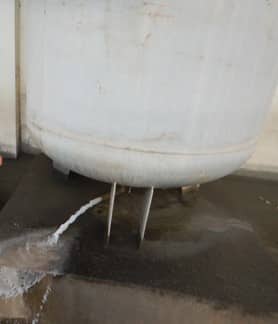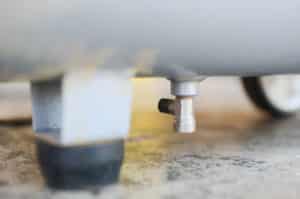There are a lot of questions out there about draining air compressor like – Why must air tanks be drained? How often? And how to drain it?
This article is all about the importance, frequency, and ways of draining air compressor tank. In addition, you will also learn about automatic draining.
So let’s get started.
Table of Contents
Why Drain Water from Compressed Air Tanks
The air in the atmosphere always contains some water vapor. When you run an air compressor it gets heated. And therefore, the vapor isn’t condensed into water. But when you stop it, it gets cooled. At this stage, the vapor easily condensed as the pressure is high and the temperature is low.
This water deposited in the compressor tank and that results in the followings –
A Decrease in Air Volume
Gradual deposition of water in air compressor decreases the tank volume. As a result, if you need some emergency supply, the air compressor won’t be able to provide it as it is filled with water instead of air.
Rusting
For rusting you need two agent – water and oxygen and both are present in an air compressor tank. They easily come in contact with the iron made tank if it’s not galvanized or there is no protective layer of paint.
Risk of Bursting
An air compressor tank is made in such a way that it can endure the pressure that it can generate. But if the rusting is going on inside the tank for a long time, the wall gets thinner. As a result, the compressor tank will not pose the same endurance and this could burst at any time.
Disturbance with Air Tools
Water!
Air tools don’t love them.
Suppose for a paint sprayer, if it gets water instead of air, you will get a mixture of water and paint that will result in uneven painting. Induction of water inside an air tool reduces its performance and even can damage it. It also creates a problem by mixing with the oil in air tools.
How Often Should You Drain Air Compressor
Air tanks should be drained on a regular basis for efficiency of the compressor and durability.
The draining period will depend on the intensity of using the air compressor. If you run it continuously for a couple of hours, give it brake and drain the tank.
But if are not a power user, you should drain it every time you have completed the task for the day. This way it will be free from any kind of task as there will be no water in the tank.
This is highly recommended that you drain your air compressor every day as this is not a mammoth task.
Never forget to drain it in every week. However, if there is a chance you are lazy like me and forget to drain manually go for automatic draining.
How to Drain Air Compressor Tank
There are two ways to drain your air compressor. You can drain it manually or use an automatic drain valve for air compressor. You can adopt any of these two methods to remove water from the air compressor. Both methods are efficient.
Method 1: Drain Air Compressor Manually
Step1: Locate the Air Compressor Drain Valve
In most of the cases, the drain valve is located at the bottom of the tank whatever the designed position is.
But in some cases, you can find this on the side of the tank. This is done with an intention that the water can be drained out by the air pressure.
But there are several disadvantages of such a design such as this is not possible to drain the tank if there is not enough pressure inside. Another disadvantage of such position of drain valve is that it can be clogged up with the rust. But the advantage is that the side valve is easy to open and close.
Step 2: Open the Drain Valve and Drain Out All the Water and Sludge
Just after you open the drain valve rotating the knurled ring in the anticlockwise direction water will start to come out due to gravity if the valve is located at the bottom of the tank.
But in the case of a drain valve located at the side of the air compressor, you need some pressure in the tank. If there is no pressure, start the compressor to get some pressure. Afterward, stop the compressor and open the valve. The pressure will drive out the water from the tank.
Always remember to have a pan or bucket at the bottom of the drain valve.
Why?
There are two reasons for that – you don’t want the floor to be flooded with water and be dirty with the rust solution. I recommend you to wear gloves if you don’t want to get your hands dirty.
When you drain a compressor tank, open the valve fully. This is because sometimes you can see the bubbles coming out from the tank and assume that water is drained fully. But it’s not finished yet. This happens because the sludge blocks the little passage that you created opening the valve partially.
Again if the drain valve is at the bottom, you can also wash the tank with water to remove all the rust and oil sludge. You have to remove the whole valve from the tank to do so. Use a water hose to wash the inside of the tank. You can also paint the inside to prevent rust.
Step 3: Close the Drain Valve and Check It is Not Leaking
After you have drained all the water and washed the sludge its time to close the drain valve carefully.
If you have removed the whole drain valve, use new thread tape over the drain valve to prevent a leak when you reinstall it in the air compressor.
To check if there is any kind of leak, use soap bubble to detect it. First, run the compressor to build some pressure. Now cover the drain valve with soap bubble. If the bubble popped, there is a leak. In that case, tight it more using a wrench. Again if it still shows leak, use more thread tape over the drain valve.
Method 2: Using an Air Compressor Automatic Drain Valve For Schedule Draining

When you don’t want to drain the tank manually the only way to do so is to attach an electronic automatic drain valve.
You can set the timer according to the operation frequency and time duration. They are powered from the 12V wall source and also can be wired with the control system so that they can monitor the function.
To install the automatic drainer, screw out the manual one and screw in the automatic one. Now plug it in the wall socket to power it up.
How to Set Timer in an Automatic Drain Valve
For setting the timer you will have knob and by turning them you can cycle the device for draining. The timer can be calibrated for hours or days. I will recommend you cycle it to drain once daily.
At the time of functioning, this will open up the valve and drain the water and close it again. Always keep a pan or bucket below the drain valve to collect the drained water from the air compressor tank.
We Recommend this Electronic Automatic Tank Drain for Air Compressors from Suburban. It is self-cleaning and you won’t face any clogging because of the built-in strainer.


I get moisture out of my drain but no air?
If you’re not getting a sudden rush of air when you open the drain of your air compressor, either it’s not open all the way, or there’s debris in the way that’s keeping it plugged, but allowing some moisture to creep through or around it. It would be a good idea to wait for the tank pressure to be zero, remove the drain valve, and gently poke through the hole to see if there’s anything covering it. Then try running the air compressor briefly again and see if air is rushing out of the hole the valve goes in. Make sure to clean out all of the gunk so the valve doesn’t get covered up. If it’s rusty scale, you may want to have someone look at the inside of your tank to make sure the rust hasn’t affected the integrity of the tank. If it’s not bad and the hole for the valve is clean, you should be able to re-install the valve and go back to using your air compressor—remember to drain it of any moisture daily.